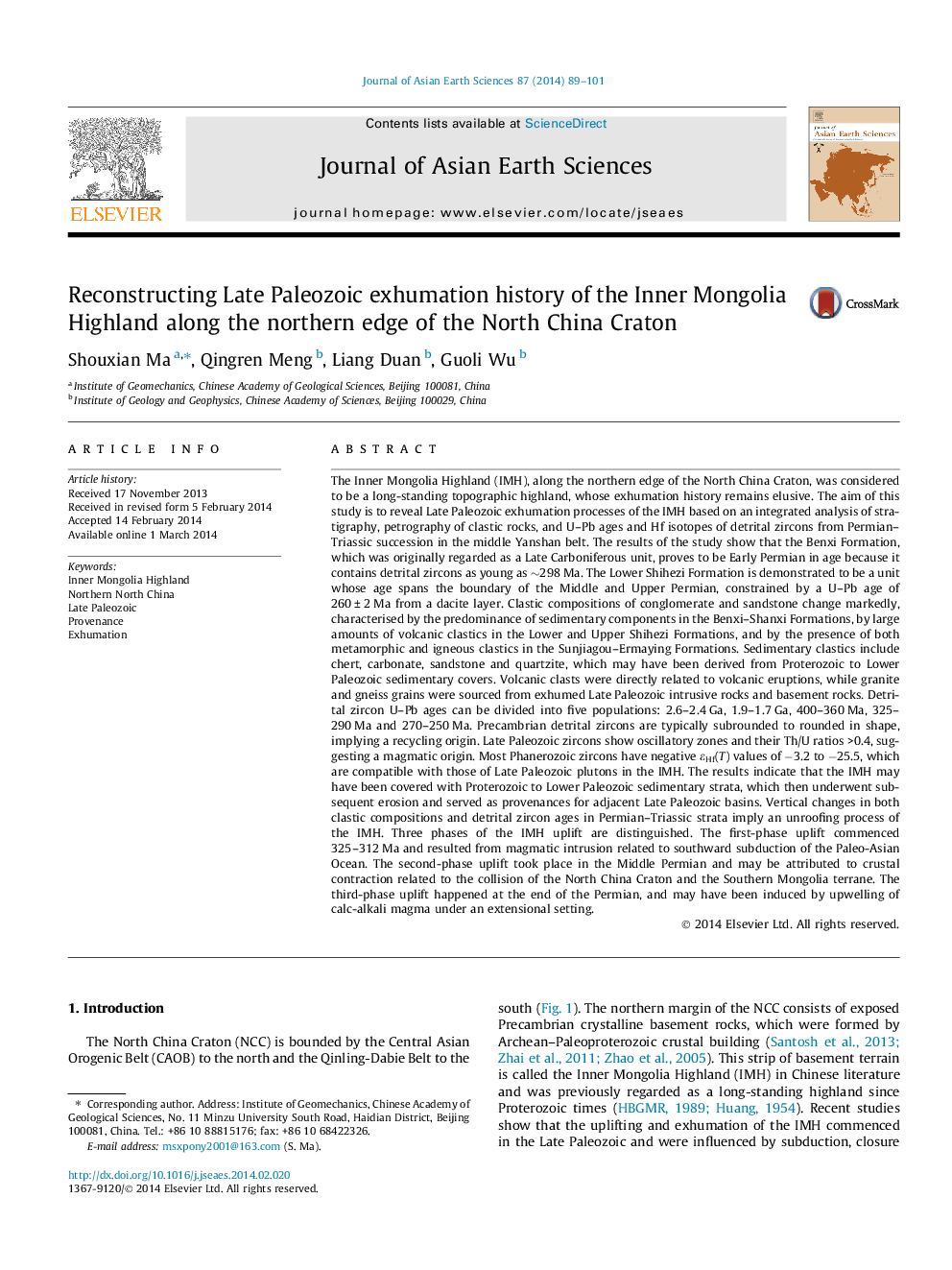| کد مقاله | کد نشریه | سال انتشار | مقاله انگلیسی | نسخه تمام متن |
|---|---|---|---|---|
| 6444417 | 1640381 | 2014 | 13 صفحه PDF | دانلود رایگان |
عنوان انگلیسی مقاله ISI
Reconstructing Late Paleozoic exhumation history of the Inner Mongolia Highland along the northern edge of the North China Craton
ترجمه فارسی عنوان
بازسازی تاریخ انقراض پالئوزوئیک پس از سرزمین اصلی مغولستان در امتداد لبه شمالی کرتون شمالی چین
دانلود مقاله + سفارش ترجمه
دانلود مقاله ISI انگلیسی
رایگان برای ایرانیان
موضوعات مرتبط
مهندسی و علوم پایه
علوم زمین و سیارات
زمین شناسی
چکیده انگلیسی
The Inner Mongolia Highland (IMH), along the northern edge of the North China Craton, was considered to be a long-standing topographic highland, whose exhumation history remains elusive. The aim of this study is to reveal Late Paleozoic exhumation processes of the IMH based on an integrated analysis of stratigraphy, petrography of clastic rocks, and U-Pb ages and Hf isotopes of detrital zircons from Permian-Triassic succession in the middle Yanshan belt. The results of the study show that the Benxi Formation, which was originally regarded as a Late Carboniferous unit, proves to be Early Permian in age because it contains detrital zircons as young as â¼298 Ma. The Lower Shihezi Formation is demonstrated to be a unit whose age spans the boundary of the Middle and Upper Permian, constrained by a U-Pb age of 260 ± 2 Ma from a dacite layer. Clastic compositions of conglomerate and sandstone change markedly, characterised by the predominance of sedimentary components in the Benxi-Shanxi Formations, by large amounts of volcanic clastics in the Lower and Upper Shihezi Formations, and by the presence of both metamorphic and igneous clastics in the Sunjiagou-Ermaying Formations. Sedimentary clastics include chert, carbonate, sandstone and quartzite, which may have been derived from Proterozoic to Lower Paleozoic sedimentary covers. Volcanic clasts were directly related to volcanic eruptions, while granite and gneiss grains were sourced from exhumed Late Paleozoic intrusive rocks and basement rocks. Detrital zircon U-Pb ages can be divided into five populations: 2.6-2.4 Ga, 1.9-1.7 Ga, 400-360 Ma, 325-290 Ma and 270-250 Ma. Precambrian detrital zircons are typically subrounded to rounded in shape, implying a recycling origin. Late Paleozoic zircons show oscillatory zones and their Th/U ratios >0.4, suggesting a magmatic origin. Most Phanerozoic zircons have negative εHf(T) values of â3.2 to â25.5, which are compatible with those of Late Paleozoic plutons in the IMH. The results indicate that the IMH may have been covered with Proterozoic to Lower Paleozoic sedimentary strata, which then underwent subsequent erosion and served as provenances for adjacent Late Paleozoic basins. Vertical changes in both clastic compositions and detrital zircon ages in Permian-Triassic strata imply an unroofing process of the IMH. Three phases of the IMH uplift are distinguished. The first-phase uplift commenced 325-312 Ma and resulted from magmatic intrusion related to southward subduction of the Paleo-Asian Ocean. The second-phase uplift took place in the Middle Permian and may be attributed to crustal contraction related to the collision of the North China Craton and the Southern Mongolia terrane. The third-phase uplift happened at the end of the Permian, and may have been induced by upwelling of calc-alkali magma under an extensional setting.
ناشر
Database: Elsevier - ScienceDirect (ساینس دایرکت)
Journal: Journal of Asian Earth Sciences - Volume 87, 15 June 2014, Pages 89-101
Journal: Journal of Asian Earth Sciences - Volume 87, 15 June 2014, Pages 89-101
نویسندگان
Shouxian Ma, Qingren Meng, Liang Duan, Guoli Wu,
